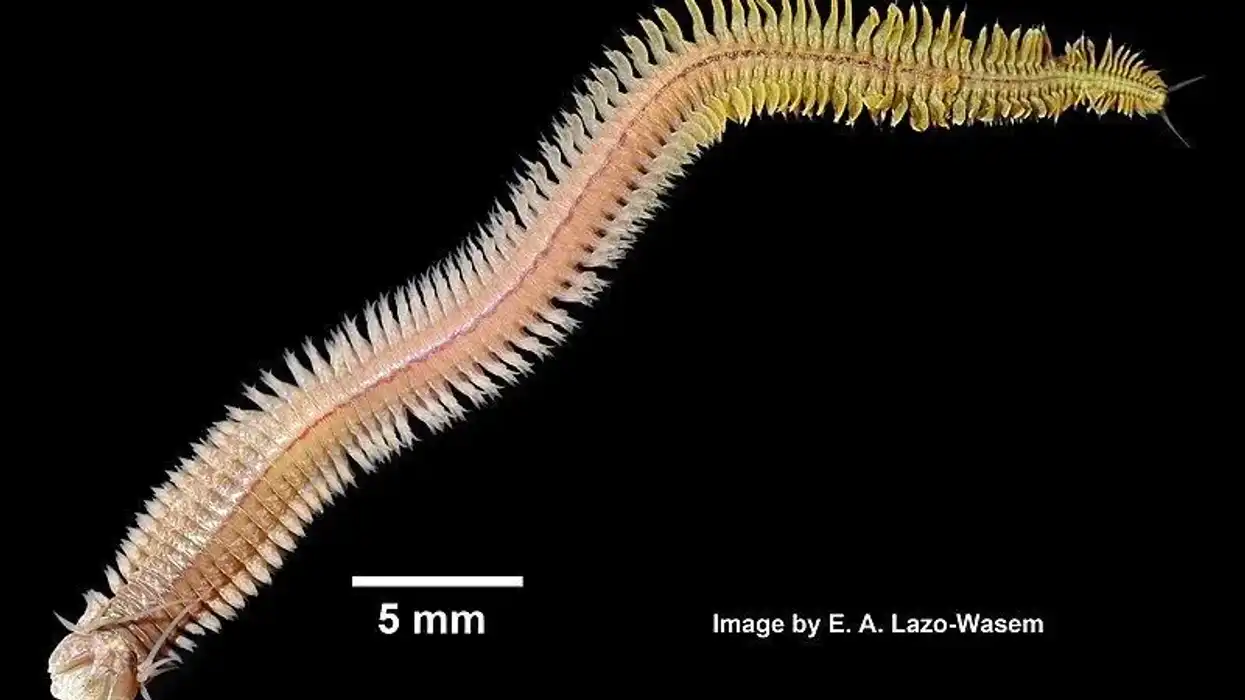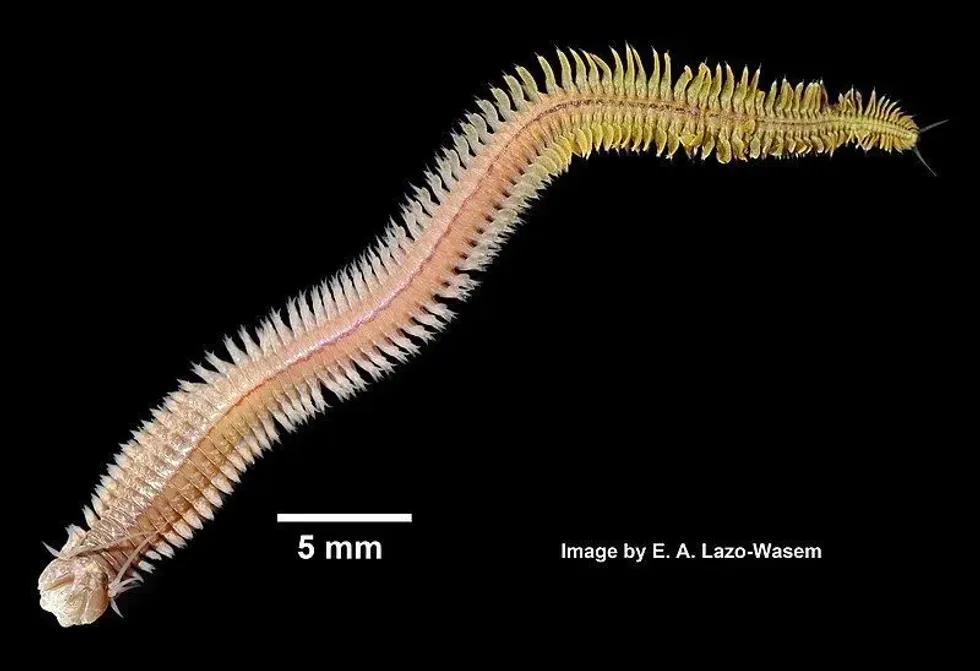The clam worm (scientific name Alitta succinea) is a member of the Nereididae family. This worm may come off as scary in terms of its looks, but it sure plays an important role in the marine ecosystem and food chain.
With four eyes, one mouth and a fang-like proboscis, clam worms sure are slightly terrifying. One of the greatest features about these worms is that they can secrete a mucus-like substance, which can harden like a shell. This is also how the worm gets its name.
Clam Worm Interesting Facts
What type of animal is a clam worm?
A clam worm or a pile worm, as the name suggests, is a worm that can be seen at the bottom of a water body. This species is named Alitta succinea and is found in many different parts of the world.
What class of animal does a clam worm belong to?
The scientific name of the class that clam worms (Alitta succinea) belong to is known as Polychaeta. However, we can just as easily classify them as worms.
How many clam worms are there in the world?
Unfortunately, there are no conclusive records which would be able to tell us the number of clam worms there are in the world. However, as they can survive in many types of waters and exist worldwide, we can safely assume that their population is abundant.
Where does a clam worm live?
The clam worm is a marine worm species. It is found at the bottom of water bodies. While it is sometimes found at the top of a water body for breeding, it remains at the bottom for the majority of its life.
What is a clam worm's habitat?
Clam worms can be found at the bottom of a variety of water bodies. For this reason, they are found worldwide. The clam worm habitat is pretty widespread, which is why it is tough to find an estimate of their population count.
Who do clam worms live with?
Clam worms are bottom dwelling creatures, and hence, it is difficult to study them closely. There is no evidence to tell us if they are sociable worms or like to be alone all the time.
How long does a clam worm live?
According to research, the entire life of a clam worm is concluded in two to five years. During the breeding season, the body of a clam worm starts to float on the surface of the water body that it inhabits. Once it has released either eggs or sperm for reproduction, the worm dies.
How do they reproduce?
The breeding season for clam worms is dependent on lunar phases. These worms typically breed during the spring and summer months.
During these lunar phases, their bodies become able to float on top of the sea. From their raised position, females release their eggs and males release their sperm, after which, they die. These worms are also known for performing epigamy, which is a process where they try to attract the opposite sex.
What is their conservation status?
Nothing is outlined in the IUCN Red List regarding the conservation status of Alitta succinea. This leads to the assumption that unlike some sandworms and tubeworms which are critically endangered, clam worms are safe in terms of their population count.
Clam Worm Fun Facts
What do clam worms look like?
The most striking feature about clam worms (Alitta succinea) is their tentacles. They have many tentacles throughout the sides of their body, and just four on their head. This species is brown or reddish brown in color. Only the rear end of clam worms' bodies are brown in color, and the rest of the portion has a reddish tint.
The worm has four eyes on its head, and has some sensory organs as well. These sensory organs are known as palps.
They also have a proboscis which is a prong-like structure that helps the creature in eating food. Below their many eyes is a mouth which is used for eating. They also have side flaps, through which they breathe underwater.
The proboscis, however, is not always the greatest thing. When their sensory organs recognize a threat, clam worms get ready to bite their opponent through their proboscis and strong jaw. Hence, this marine species is not devoid of its own ways of protecting itself in dangerous situations.

How cute are they?
The clam worm (Alitta succinea) is a pile worm species which is characterized by its many tentacles. Whether or not the species is adorable is something that is subjective. The tentacles, many eyes and the brown colored rear end do not exactly paint a pretty picture.
How do they communicate?
Unfortunately, there is insufficient research in terms of how clam worms communicate with each other. The clam worm genus as a whole is poorly researched and there is not much knowledge about the life of these creatures.
How big is a clam worm?
A clam worm can grow to be 6 in (15 cm) long. This is not a great length, but clam worms develop enough features, such as their jaws, eyes, and mouth, which help in their survival.
How fast can a clam worm swim?
Unfortunately, there is no evidence to tell us how fast a clam worm can drag the length of its body across the bottom waters of many water bodies. However, the many tentacles on the creature's body does support the theory of fast movements.
How much does a clam worm weigh?
There are no records regarding the weight of a clam worm. However, given the very small length to which creatures of this species grow, it can be assumed that their weight is negligible.
What are male and female names of the species?
There are no special names for male and female clam worms. Hence, if you find any clam worms floating on tidal waters, you can simply refer to these marine worms as a male clam worm and female clam worm.
What would you call a baby clam worm?
Clam worm babies start as planktonic larvae. The Alitta succinea species starts as larvae and stays afloat on a water body.
As more and more body parts develop, the pile worm sinks to the bottom of the same water body and spends the rest of its life there, until the month of March or April approaches. At this time, the worm floats again and dies shortly after releasing its eggs or sperm.
There is no specific name to address a clam worm's baby.
What do they eat?
Since it is a bottom dwelling creature, a clam worm would most commonly be found eating other worms that can readily be found in the surrounding areas. Clam worms also feed on small fish, and in turn, are even eaten by some other species of slightly larger fish.
It is common to use this marine creature as bait for fish.
Are they dangerous?
The Alitta succinea is characterized by its strong jaws and tendency to bite whenever a threat is near. Even though the body length of this pile worm is very short, it packs a punch in terms of its bite.
A clam worm bite can be very painful, as the creature brings out fang-like protrusions which it uses for eating food.
Would they make a good pet?
Even though choosing food and a habitat for this reddish-brown bottom dwelling worm is fairly simple, it is not common to have clam worms as pets.
They grow into a very small length and develop partially scary features such as four eyes and many tentacles, which may not be the greatest sight in terms of what you want to see around the house on a daily basis.
Did you know...
The Alitta succinea worm species breeds in the months of April and March. The rear end of the worm is brown in color.
Are clam worms dangerous?
Clam worms aren't exactly dangerous but you may want to stay away from them. In terms of their proboscis, these worms feel no hesitation in digging them into human skin as and when needed.
What eats clam worms?
Fish and other marine creatures eat clam worms.
*We've been unable to source an image of an Alitta succinea and have used an image of a Nereis succinea instead. If you are able to provide us with a royalty-free image of an Alitta succinea, we would be happy to credit you. Please contact us at hello@kidadl.com.










